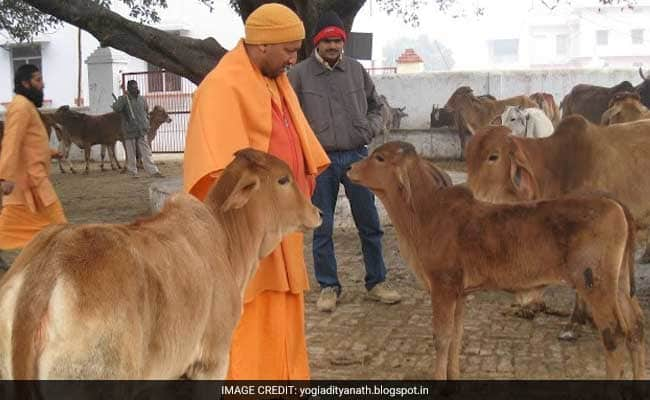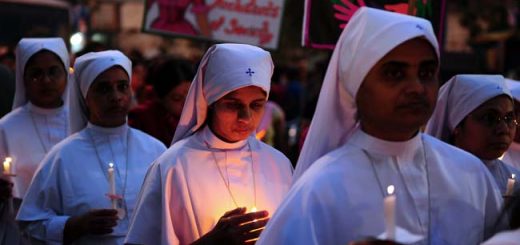GETTING COWED DOWN

Cover Photo: UP Chief Minister Adityanath Yogi with cows.
# chhotebhai

This phrase means living in fear. There is also another phrase “getting bogged down”, which means getting stuck in a quagmire, from which it is impossible to extricate one’s self. This is what seems to have happened in Yogi Adityanath’s U.P., where I live.
When he became the Chief Minister two years ago he boldly declared a moratorium on all “illegal slaughter houses” and meat shops that included buffalo, mutton, pork and poultry. Over zealous cops and assorted other sarkari babus swooped down on the meat industry, ostensibly on the grounds that they were functioning under unhygienic conditions. The CM’s gaze did not fall on filthy chai shops and chaat vendors. Till today many meat vendors are functioning “illegally” because the authorities have not renewed their licences. So they are at the mercy of the extortionist cops. They are cowering in fear.
On the other hand the entire State administration has got bogged down with a mammoth cow crisis, further compounded by all roads leading to Prayagraj for the Ardh Kumbh extending over 49 days from January to March. Govt officials are therefore either pre-occupied with the pilgrims at Prayagraj that run into crores, or in tackling the cattle menace that has now attained critical mass, and could implode on the State anytime soon.
By now the public has seen enough images, or read about desperate villagers herding stray cattle into Govt schools and health centres in U.P. Instead of seriously addressing the problem the State has gone on the offensive against the hapless villagers.
Ever since Yogi and the Central Govt cracked down hard on what it calls cow slaughter, the situation has turned ugly and snowballed out of control. I will quote from some recent reports in the Hindustan Times to show how grave the situation is. The paper says that the Cattle Census of 2012 lists 31.18 lakh stray or abandoned cows in U.P. alone. After the crackdown that figure could now be closer to 40 lakhs today. According to the same Census the total number of cows and bulls were 1.95 crores. It is not clear if this figure includes buffaloes as well. Even so the number could now be about 2.2 crores.
Now let us translate these figures into expenditure and space. My friend Suresh Gupta, the Secretary of the Kanpur Gaushala Society that cares for 1200 cattle, says that fodder for a cow, even if not lactating, costs Rs 120/- per day, or Rs 43,800/- per annum. 40 lakhs of abandoned cattle would require a staggering Rs 17,520 crores per annum, just to be fed. Add to that the infrastructure and personnel costs for housing and caring for them, and the figure could easily touch 20,000 crore rupees per annum.
Now for space. Anupam Srivastava, writing in the Hindustan Times, quotes Dr Arvind Rao, Chief veterinary Officer of the Lucknow Municipal Corporation to say that each head of cattle requires 300 sq ft of living and moving space. 2.2 crores of cattle would then require 660 crore sq ft. Where is this going to come from? Contrast this with human beings. How many Indians can afford food worth Rs 120/- per day? As for living space, a small family of four may be living in a chawl or hut having the same 300 sq ft, or 75 sq ft per head. Obviously then the cow has become far more precious and important than human beings.
What has been the response of the Central and U.P. Govts that consider the cow sacred? In its 2019-20 Union Budget, the Central Govt has allocated a mere 750 crore rupees for cattle care across the country, not just U.P. In a desperate act Adityanath has levied a cess on, would you believe it, alcohol! So the profane guzzlers will be shelling out Rs 1/- to Rs 10/- per bottle for protecting the sacred cows. The height of hypocrisy. And what is the State getting out of it? A paltry sum of Rs 165 crore rupees, or less than 1% of its annual requirement of 20,000 crore rupees. Add to this the loss in good governance, because all sarkari babus are running after stray cattle or trying to build shelters with the peanuts allocated for them.
Another knee jerk reaction to the crisis is to have sex selection of cattle through segregation of the X and Y chromosomes in the semen used for artificial insemination. Ironically this semen is coming from the USA, and costs Rs 1300/- per dose! So will we get profane cattle from the much despised decadent “western culture” or truly “sacred Indian” cattle? Even the quintessential Baba Ramdev is importing semen from European stud bulls for his cows to produce “desi ghee”! This sucks.
Brajendra Prashar, the Hindustan Times correspondent that I have quoted, sums it up beautifully, “The Yogi Adityanath Govt might not have anticipated the magnitude of the crisis that lay in store for it when it tightened the noose around illegal slaughter houses in the State after taking over the reins in March 2017”. I wonder if Vedic maths includes Newton’s Third Law of Motion; that for every action there is an equal and opposite reaction? Society goes beyond mathematical equations. It is a force multiplier, where the reaction can be far more than the original action. Some people never learn that surgical strikes don’t work, they only leave deep scars, for which the nation pays a heavy price.
So far I have only written about the direct costs. What about the loss of crops and man hours wasted by farmers guarding their crops all night against hungry, marauding cattle?
Let us now examine the flip side. How much are we losing by abandoning our cattle? Interestingly we don’t see abandoned buffaloes in either city street or village field. This is because every single part of the buffalo, barring the eyes, comes into commercial/ productive use.
Qazi Naiyer Jamal, General Secretary, Leather Industries Welfare Association, Kanpur
According to Qazi Naiyer Jamal, General Secretary, Leather Industries Welfare Association, Kanpur; even a dead animal gives direct employment to 90 persons; starting from the horse cart owner who picks up the carcass, to the persons skinning it, to salting the hide, removing, crushing and refining the bones etc. If it is a healthy animal that is culled (I won’t use the harsh term slaughtered), other than its meat, the horns are used for making combs, the hair for brushes, the ears for dog chew, the blood for ferrous medicines, the intestines for sausages, the waste material for poultry feed and organic manure, the hooves for glue and gelatine, and the stomach is exported for tripe, a western delicacy.
Small wonder that a milch buffalo, even after its lactating days are over, sells for Rs 20,000/- to Rs 25,000/- depending on its weight. Mohd Iqbal Khalid, a leather merchant, says that even the hide is split into two parts, known as leather grain and split leather. Most of those employed in the leather industry are unskilled labour, either dalit or Muslim. Imagine the loss to the economy if we have 40 lakh stray cattle, even if we don’t touch the flesh.
There is yet another aspect that needs to be highlighted. Hindu Ahirs usually rear cows for milk, whereas the Muslim Ghosis first choice is the buffalo, because they have an assured return. The alarming rise in abandoned cattle after the ban, including the limitations on cattle fairs, is indicative that indeed post lactating cows were being sold by Hindus to those who were ready to purchase them, in all probability Muslims. So both parties are “equally culpable”, the seller and the buyer. Now that they are losing the “post retirement benefits” of Rs 20,000/- per cattle head, they are also losing their tempers and venting it on the Govt. It has compounded the agrarian distress that was evident in the Assembly polls in three States in the “cow belt”.
Mohd Iqbal Khalid
The Govt’s other obsession with clean water in the Ganga for the Kumbh Mela in Prayagraj, 200 kms downstream from Kanpur, has resulted in the forced closure of 402 tanneries in Kanpur, rendering over one lakh workers jobless, and sending export commitments haywire. Jamal says that at the recent International Leather Fair in Garda, Italy, foreign buyers were shunning Indian exporters because of the uncertainty in the industry. In contrast, Jamal says that neighbouring Bangladesh gives the leather industry a 15% subsidy, thereby rendering them more competitive in international markets.
Jamal has another grouse. After the closure of the tanneries, their Sewage Treatment Plants with a combined capacity of 214 million litres per day, are now being used for treating municipal sewage, to keep the Ganga clean. So the tanneries have become the sacrificial goat. What the future holds in store is anyone’s guess.
But I will hazard a guess. It is well nigh impossible to change the religious sentiments of those who consider the cow sacred, be it on economic, rational or mythological lines. But nature, like water, will find its course. I anticipate a major depletion in the cow population; not because of slaughtering, but because dairy farmers will switch to a more viable alternative – the ubiquitous buffalo. They will get more milk, more fat content, and a handsome golden handshake when they sell the animal after it has stopped lactating. Maybe it is a blessing in disguise. So there is no need to get cowered down.
* The writer is a social thinker and activist.

















